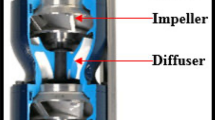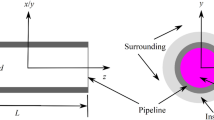Abstract
This study investigates characteristics of transient flow and the possibility of freezing in a pressure regulator and the rear connecting pipe of the pressure regulator during the closing process of the pressure control valve (PCV), which is an essential element in the operation of a natural gas pipeline network. For this purpose, the study develops a numerical model for the PCV and its rear connecting pipe by applying computational fluid dynamics method. The analysis is conducted in each of two cases: (1) a steady-state analysis in the case of normal operation and (2) an unsteady-state analysis in the case of emergency closure in problematic situations. First, we closely examine characteristics of internal flow in the pressure regulator and the rear connecting pipe when the PCV operates regularly with a 50% opening ratio in a steady state. Afterwards, unsteady-state analysis examines characteristics of transient flow, such as lowered pressure and temperature, velocity change, etc., of rear flow in the pressure regulator when the PCV is closed because of trouble in the pressure control system.
Similar content being viewed by others
References
A. R. Kleinig and A. P. J. Middelberg, The correlation of cell disruption with homogenizer valve pressure gradient determined by computational fluid dynamics., Chemical Engineering Science 51(23) (1996) 5103–5110.
Y. J. An, B. J. Kim and B. R. Shin, Numerical analysis of 3-D flow through LNG marine control valves for their advanced design, JMST 22(10) (2008) 1998–2005.
S. L. Ke and H. C. Ti, Transient analysis of isothermal gas flow in pipeline network, Chem. Eng. J. 76 (2000) 169–177.
R. P. Benedict, Fundamentals of pipe flow, Wiley (1985) 292–342.
Fluent Inc., FLUENT 6.1 User’s Guide (2003).
P. Fiorentini, Pressure regulator manual (2001).
C. H. Shin and J. M. Ha et al., A study about critical flow characteristics and the pipeline network modeling of a pressure regulator (I), KSME(B) 29(12) (2005) 1291–1298.
C. H. Shin and J. M. Ha et al., A study about critical flow characteristics and the pipeline network modeling of a pressure regulator (II), KSME(B) 29(12) (2005) 1299–1306.
C. H. Shin and J. M. Ha et al., Transient pressure character-istics in a pressure regulating system by using 1-D analytic valve modeling, JMST 22 (2008) 1–10.
F. M. White, Fluid dynamics, 4th ed., McGraw-Hill (2001) 571–618.
A. H. Shapiro, The dynamics and thermodynamics of compressible fluid flow, Ronald, New York (1953).
Crane Co., Flow of fluids through valves, Fittings and Pipe, Crane Valve Group (CVG) Technical Paper No. 410 (1985).
Author information
Authors and Affiliations
Corresponding author
Additional information
Recommended by Associate Editor Do Hyung Lee
Chang-Hoon Shin Principal researcher/Part leader (P.L.), E&P research part, R&D division, Korea Gas Corporation (KOGAS); Project manager (P.M.) of the Korea National Research Project, “Shale and tight gas field development technology,” project by the Ministry of Knowledge and Economy of Korea.
Rights and permissions
About this article
Cite this article
Shin, CH. A numerical study on the characteristics of transient flow in a pressure regulator resulting from closure of the pressure control valve. J Mech Sci Technol 27, 443–449 (2013). https://doi.org/10.1007/s12206-012-1257-y
Received:
Revised:
Accepted:
Published:
Issue Date:
DOI: https://doi.org/10.1007/s12206-012-1257-y




